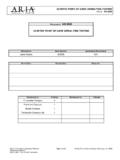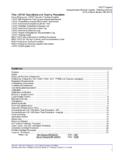Transcription of Kaolin Activated Clotting Time - Point-of-care testing
1 Kaolin Activated Clotting time . PROC #: Philadelphia / Langhorne, PA. PROCEDURE # Kaolin Activated Clotting time . PREPARED BY DATE ADOPTED SUPERSEDES PROCEDURE #. Janet Swaim 1/2005 POC-12. REVIEW DATE REVISION DATE SIGNATURE. DISTRIBUTED TO # COPIES DISTRIBUTED TO # COPIES. Torresdale lab 1. Hospital Intranet 1. Dept. of Pathology & Laboratory Medicine Page 1 of 6 Kaolin Activated Clotting rev. 10/09. Departmental Manual Key Contact: Point of Care Coordinator Kaolin Activated Clotting time . PROC #: Philadelphia / Langhorne, PA. PRINCIPLE: The I-STAT Kaolin Activated Clotting time test, Kaolin ACT, is a measure of the time required for complete activation of the coagulation cascade. The endpoint is indicated by the conversion of a thrombin substrate other than fibrinogen and an electrochemical sensor is used to indicate the event of this conversion. The substrate used in the electrogenic assay has an amide linkage that mimics the thrombin-cleaved amide linkage in fibrinogen.
2 The substrate is H-D-phenylanyl-pipecolyl-arginine-p- amino-p-methoxydiphenylamine. Thrombin cleaves the amide bond at the carboxy-terminus of the arginine residue because the bond structurally resembles the thrombin-cleaved amide linkage in fibrinogen. The product of the thrombin- substrate reaction is the electrochemically inert tripeptide phenylalanyl-pipecolyl-arginine and the electroactive compound NH3+-C6H4-NH-C6H4-OCH3. The formation of the electroactive compound is detected amperometrically, and the time of detection is measured in seconds. SPECIMEN: Patient Preparation: Patient is identified using the name and date of birth Specimen Collection and Preparation: The I-STAT Kaolin ACT test can be performed using venous or arterial samples. Venipunctures and Arterial Punctures: 1. Collection technique resulting in good blood flow must be used. 2. The sample for testing is drawn into a plastic collection device (either a plastic syringe or plastic evacuated tube).
3 3. The collection device cannot contain anticoagulants such as heparin, EDTA, oxalate, or citrate. 4. The collection device cannot contain clot activators or serum separators. 5. The sample is immediately dispensed into the sample well of a cartridge. 6. If a second measurement is required, a fresh sample must be obtained. Indwelling Line: 1. Temporarily stop the IV drip. 2. If blood must be drawn from an indwelling line, possible heparin contamination and specimen dilution should be considered. The line should be flushed with 5 ml of saline and the first 5 ml of blood or six dead space volumes should be discarded. 3. Withdraw the sample for testing into a fresh plastic syringe. 4. The collection syringe cannot contain anticoagulants such as heparin, EDTA, oxalate, or citrate. EQUIPMENT AND MATERIALS. Equipment: i-STAT1 clinical analyser. The analyzer remains on a flat surface with the display facing up during testing . If the analyzer is not level, the ACT result may be affected by more than 10%.
4 Dept. of Pathology & Laboratory Medicine Page 2 of 6 Kaolin Activated Clotting rev. 10/09. Departmental Manual Key Contact: Point of Care Coordinator Kaolin Activated Clotting time . PROC #: Philadelphia / Langhorne, PA. Materials: Each I-STAT ACT cartridge provides a sample collection chamber, sensors to detect the coagulation endpoint and dry reagents necessary to initiate and allow coagulation. These reagents are coated on a section of the sensor channel and include a particulate activator, a thrombin substrate, and stabilizers. Preparation and Storage: Cartridges in sealed pouches are stable through the expiration date when stored refrigerated at 2 to 8 . C and for up to two weeks at room temperature (18-30 C). Write the date on the cartridge box to indicate the two-week room temperature expiration date. Cartridges remain in pouches until time of use. Do not use after the labeled expiration date. Upon removal from refrigeration, a box of 25 cartridges requires one hour equilibration at room temperature before use.
5 Individual cartridges require five minutes equilibration. A cartridge is used immediately after it is removed from the pouch. On receipt of new cartridges, verify that the transit temperature was satisfactory using the four-window temperature indicator strip included with the cartridge boxes. CALIBRATION: N/A. QUALITY CONTROL: Electronic Simulator: The Electronic Simulator, external and internal, is a quality control device for the analyzer's cartridge signal-reading function. It simulates two levels of electrical signals that stress the analyzer's cartridge signal detection function both below and above measurement ranges. While the analyzer performs internal electronic checks and calibration during each test cycle, the Electronic Simulator test provides an independent check on the ability of the analyzer to take accurate and sensitive measurements of voltage, current and resistance from the cartridge. An analyzer will pass or fail this electronic test depending on whether or not it measures these signals within limits specified in the analyzer software.
6 The Electronic Simulator test will fail if high humidity interferes with the measurements. Therefore, it is not necessary to record humidity where the analyzers are in use. The internal Electronic Simulator test is triggered by inserting a cartridge. If the software detects that the 8 hours has elapsed since the last Electronic Simulator test (internal or external), it will automatically perform the internal test before the sample is tested, adding about 20 seconds to the testing cycle. A failed simulator test stops the cycle. ELECTRONIC SIMULATOR FAIL will be displayed on the screen, and the sample will not be analyzed. If the test passes, the cartridge cycle continues to completion and the cartridge results are displayed in the standard way. The Electronic Simulator is a stable electronic device, which is inserted into the cartridge port of the analyzer to verify the electrical measurement as described in the paragraphs above. The test cycle for the external Electronic Simulator is about 60 seconds.
7 (The test cycle for the internal stimulator is shorter because is shares the initial part of the test cycle with the cartridge). An external Electronic Simulator is needed: Dept. of Pathology & Laboratory Medicine Page 3 of 6 Kaolin Activated Clotting rev. 10/09. Departmental Manual Key Contact: Point of Care Coordinator Kaolin Activated Clotting time . PROC #: Philadelphia / Langhorne, PA. 1. To validate an internal simulator failure. 2. To reset the internal simulator schedule if a simulator test might interrupt testing . NOTE: The external Electronic Simulator should be stored in the static-free box in which it is hipped and the blue cap should be replaced after each use to protect the contact pads. The electronic documentation when using the internal Electronic Simulator is essentially the same as when using the external Electronic Simulator. The results of the Simulator test are stored as a distinct record in the analyzer and are transmitted to the Central Data Station.
8 Remedial Action: If FAIL is displayed on the analyzer screen: 1. Repeat the procedure with the same Electronic Simulator or rerun the cartridge if the internal Electronic Simulator is being used. If PASS is displayed use the analyzer as required. 2. If FAIL is displayed, repeat the procedure with a different external Electronic Simulator. If PASS is displayed with the second Electronic Simulator: 1. Use the analyzer as required. 2. Deliver the questionable Electronic Simulator to the Point of Care Coordinator. If FAIL is displayed with the second Electronic Simulator: 1. DO NOT analyze patient samples with the analyzer. 2. Transmit the result to the Central Data Station. 3. Deliver the faulty analyzer to the Point of Care Coordinator. LIQUID QUALITY CONTROL: Two levels of liquid quality control are run on Monday or the first day of testing for the week. 1. Prior to use, allow one vial each of the lyophilized plasma and calcium chloride reconstituting fluid to stand at room temperature for a minimum of 45 minutes.
9 2. Turn on the analyzer by pressing the (1) key or the bottom right side. Press the menu key. Press the number 3 Quality Tests. Press number 1 Control. Enter your operator ID. Scan or enter the lot number of the control vial. 3. Remove the cap and stopper from the vials and pour the entire contents of the calcium chloride vial into the lyophilized plasma vial. Place the stopper back on the reconstituted vial. 4. Allow the vial to sit for 1 minute and then mix the contents by swirling gently for 1 minute, then inverting slowly for 30 seconds. 5. Use a plastic pipette, syringe, or capillary tube without anticoagulant to transfer the solution to an ACT cartridge. 6. Immediately seal the cartridge and insert it into an analyzer. This process must be completed within 30 seconds of the complete reconstitution of the control sample. 7. Compare results to the range posted on the quality control log. If results are within the expected ranges, you may run patients.
10 8. If a control is out of range, repeat the level that is out of range. If result is in range, proceed with patient testing . Dept. of Pathology & Laboratory Medicine Page 4 of 6 Kaolin Activated Clotting rev. 10/09. Departmental Manual Key Contact: Point of Care Coordinator Kaolin Activated Clotting time . PROC #: Philadelphia / Langhorne, PA. 9. If repeated control is out of range, discontinue use of that analyzer and contact the Point of Care Coordinator. PROCEDURE STEPWISE: 1. Turn on the analyzer by pressing the (1) key. 2. Remove the cartridge from its pouch. Avoid touching the contact pads or exerting pressure over the calibrate pack in the center of the cartridge. 3. Direct the dispensing tip or capillary tube containing the blood into the sample well. 4. Dispense the sample until it reaches the fill mark on the cartridge and the well is about half full. 5. Close the cover over the sample well until it snaps into place. (Do not press over the sample well).













